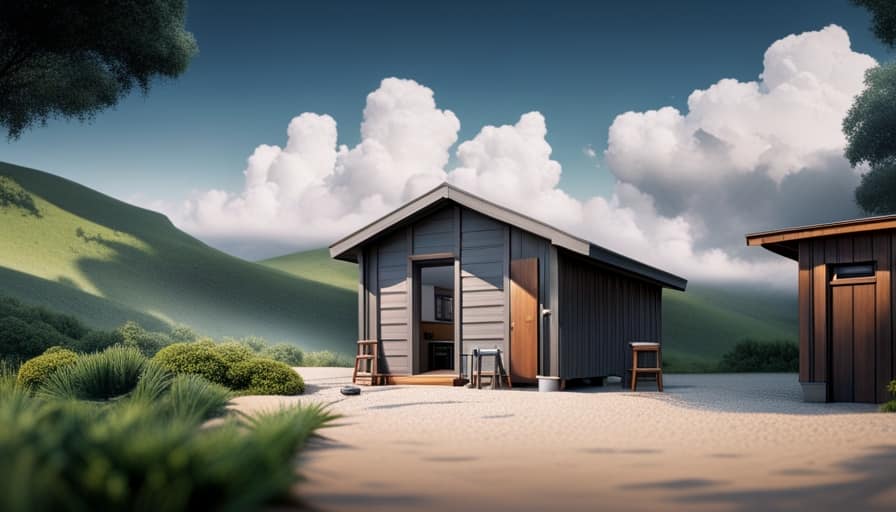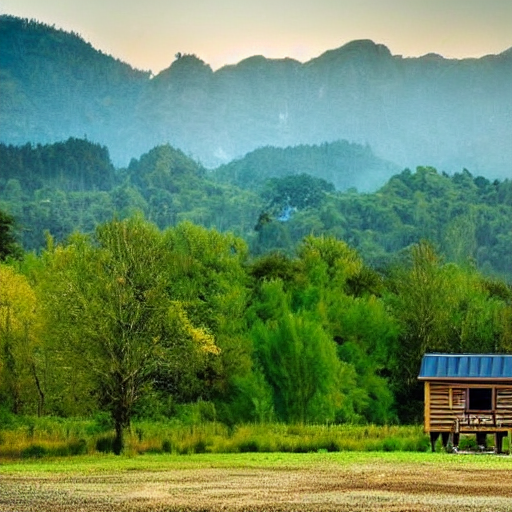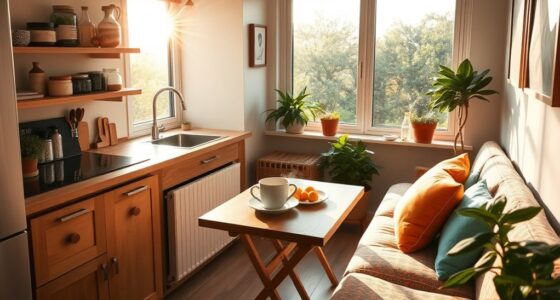I have always been intrigued by the tiny house movement and have often pondered what it would be like to live in such a compact space. In this article, we will delve into how restricted square footage affects daily life, the significance of efficient storage solutions, maneuvering through narrow pathways, and the usefulness of multi-functional furniture.
Join me as we delve into the challenges and triumphs of finding personal space in a tiny house.
Key Takeaways
- Living in a small space can lead to stress, anxiety, and claustrophobia.
- Designing for functionality and comfort can mitigate these effects.
- Maximizing storage options and using multi-functional furniture can make a tiny house feel more spacious.
- Careful planning and optimization are crucial for a functional and comfortable living environment.
The Impact of Limited Square Footage
I feel that the limited square footage of a tiny house can have a significant impact on one’s daily life. Living in a small space can lead to various psychological effects. The feeling of being cramped and confined can cause stress, anxiety, and a sense of claustrophobia. It can be challenging to find personal space and privacy in such a limited area.
However, designing for functionality and comfort can help mitigate these effects. Maximizing storage options, using multi-functional furniture, and creating open and airy spaces can make a tiny house feel more spacious and comfortable. Additionally, incorporating natural light and using light colors can create an illusion of space.
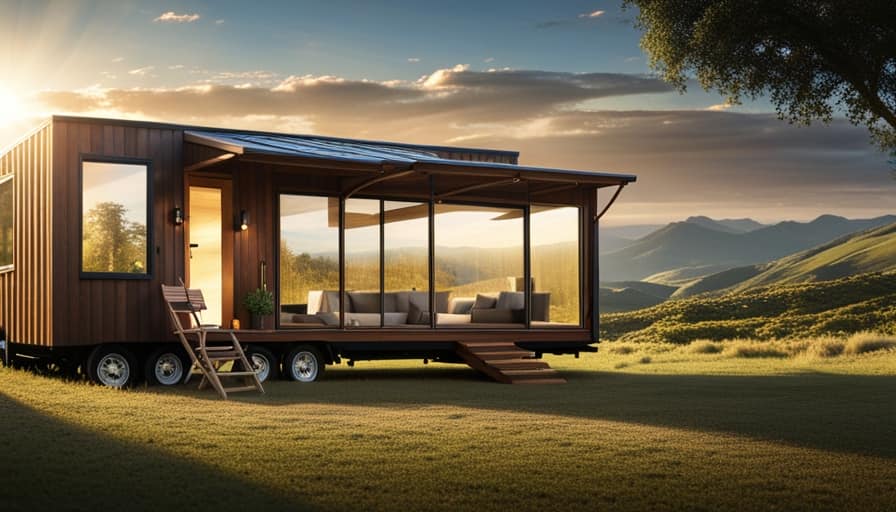
It’s important to carefully plan and optimize every square footage to ensure a functional and comfortable living environment in a tiny house.
Maximizing Storage Solutions
To maximize storage solutions in a tiny house, it is essential to utilize every available space efficiently. One way to achieve this is by exploring creative shelving options. These can include floating shelves, wall-mounted baskets, or even repurposing everyday items like old crates or ladders. By thinking outside the box, you can transform ordinary objects into functional storage solutions. Another effective strategy is to make use of vertical space. Install tall shelves or cabinets that reach up to the ceiling to maximize storage capacity. Additionally, consider utilizing the space under staircases or above doorways for additional storage opportunities. By implementing these strategies, you can optimize storage in a tiny house and create a more organized and spacious living environment.
| Creative Shelving Options | Utilizing Vertical Space |
|---|---|
| Floating shelves | Tall shelves |
| Wall-mounted baskets | Cabinets reaching up |
| Repurposed crates | Space under staircases |
| Repurposed ladders | Space above doorways |
Navigating Narrow Passageways
Navigating narrow passageways can be challenging, but with careful planning and organization, it’s possible to create a functional and easily accessible layout in a tiny house. Designing efficient layouts is crucial to ensure smooth movement within the limited space.
Here are some key strategies to consider:
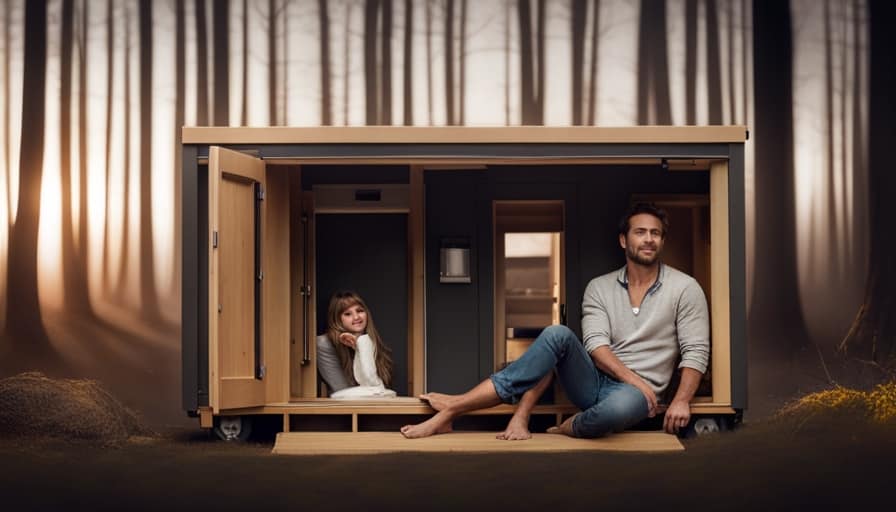
-
Utilize multipurpose furniture: Opt for furniture that can serve multiple functions, such as a sofa that can also be used as a bed or storage space.
-
Install sliding doors: Sliding doors take up less space compared to traditional swinging doors, allowing for more freedom of movement.
-
Use vertical storage solutions: Maximize vertical space by installing shelves, hooks, or cabinets to keep belongings off the floor and create a clutter-free environment.
Multi-Purpose Furniture for Versatility
One of the key solutions to maximize space in a tiny house is using multi-purpose furniture. These innovative pieces of furniture are designed to serve multiple functions, allowing you to make the most of every square inch in your tiny home. By incorporating space-saving solutions and creative design, multi-purpose furniture provides versatility and functionality without compromising on style.

Here is a table showcasing some examples of multi-purpose furniture:
| Furniture | Functionality |
|---|---|
| Sofa bed | Converts from seating to sleeping |
| Coffee table | Doubles as a storage unit |
| Murphy bed | Folds up against the wall when not in use |
| Dining table | Expands and contracts to accommodate different group sizes |
| Storage ottoman | Provides seating and hidden storage space |
These multi-purpose furniture options not only save space but also add value to your tiny house living experience. By investing in these versatile pieces, you can create a comfortable and functional living environment while maximizing every inch of your tiny home.
Finding Personal Space in a Tiny House
Honestly, sometimes it can be challenging to find personal space in a tiny house, but with a little creativity and clever organization, it’s definitely possible.
Here are some ways to create that much-needed personal space:

-
Privacy concerns
-
Carving out a designated area for oneself, such as a cozy reading nook or a small workspace, can provide a sense of privacy within the tiny house.
-
Utilizing curtains or room dividers can create separate zones, giving each person their own private space.
-
Incorporating soundproofing materials can help reduce noise and create a more secluded atmosphere.
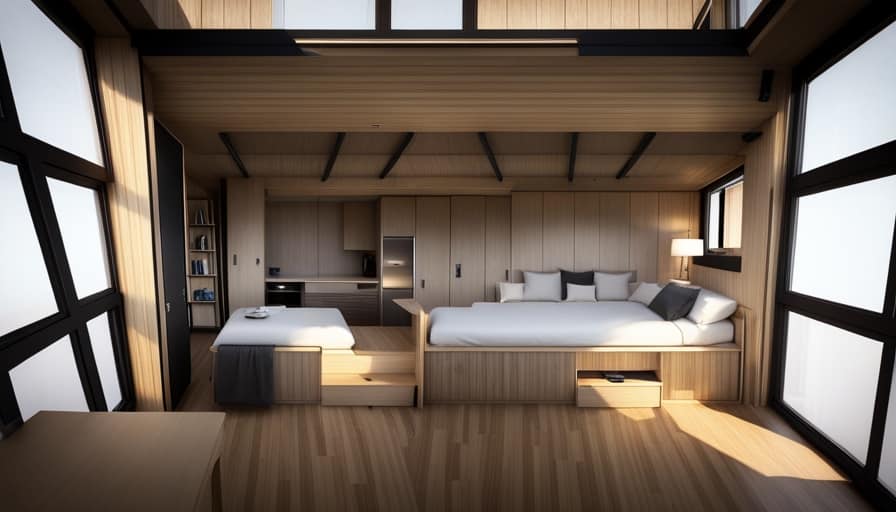
-
Designing for individual needs
-
Customizing storage solutions to fit personal belongings and keeping them neatly organized can help maintain a sense of personal space.
-
Maximizing vertical space by using wall-mounted shelves or overhead storage can free up floor space and create a more open feel.
-
Choosing furniture that serves multiple purposes, such as a bed with built-in storage or a dining table that can be folded away, can optimize space and cater to individual needs.

Frequently Asked Questions
How Much Does It Typically Cost to Build or Buy a Tiny House?
When it comes to the cost of building or buying a tiny house, it really depends on various factors such as size, materials, and location. However, there are options for financing and cost comparison to help make it more affordable.
Are Tiny Houses Suitable for Families With Children?
Living in a tiny house can be a cozy experience, but it’s important to consider the safety and impact on child development. With proper planning and organization, a tiny house can be suitable for families with children.
What Are the Main Challenges of Living in a Tiny House?
Living in a tiny house presents various challenges, primarily due to space constraints. These challenges include limited storage, lack of privacy, and difficulty accommodating guests. However, with careful planning and organization, these challenges can be overcome.
Can You Legally Park a Tiny House on Any Type of Property?
Legally parking a tiny house can be challenging due to legal restrictions and zoning regulations. However, with proper research and planning, it is possible to find suitable locations that allow for tiny house living.

How Do Tiny House Owners Handle Utilities Such as Electricity, Water, and Sewage?
In my experience, handling utilities in a tiny house requires careful planning. Tiny house off-grid solutions like solar panels and composting toilets can help with electricity and sewage. Water conservation is crucial in tiny homes to make the most of limited resources.
Conclusion
Living in a tiny house is like being trapped in a sardine can, with every inch of space meticulously utilized. The limited square footage forces residents to become masters of organization and creativity.
Navigating the narrow passageways feels like a constant game of human Tetris. Multi-purpose furniture becomes a lifesaver, transforming from a desk to a dining table to a bed in a matter of seconds.
Personal space becomes a rare luxury, making even a closet feel like a grand retreat.
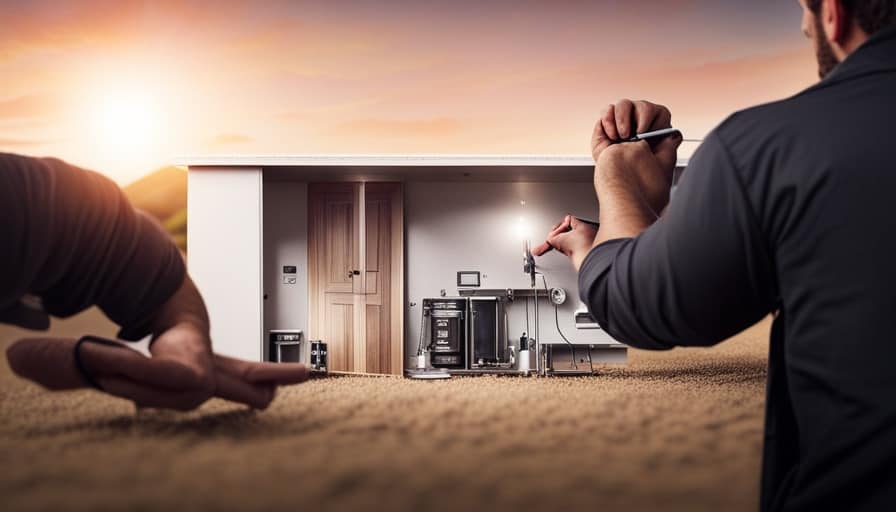
I’m Theodore, and I love tiny houses. In fact, I’m the author of Tiny House 43, a book about tiny houses that are also tree houses. I think they’re magical places where imaginations can run wild and adventures are just waiting to happen.
While tree houses are often associated with childhood, they can be the perfect adult retreat. They offer a cozy space to relax and unwind, surrounded by nature. And since they’re typically built on stilts or raised platforms, they offer stunning views that traditional homes simply can’t match.
If you’re looking for a unique and romantic getaway, a tree house tiny house might just be the perfect option.

